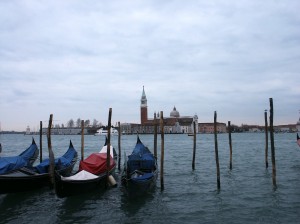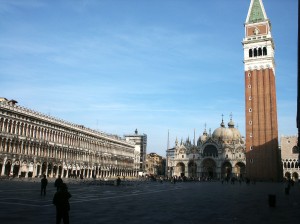Venice City Guide
We’ve visited Venice as singles, on our honeymoon, and as part of an old married couple (in fact, it was the highlight of our honeymoon trip in 2001, just a month after 9/11 when very few people were traveling and it was at its peaceful best).  It seems unreal because it is just so utterly different from anywhere else in the world. All too many people quickly see Venice on a day stop from a cruise ship or tour group, but we advocate spending at least 3 days here (if not a week) exploring all that the city has to offer or just savoring its beauty. The city’s official website is quite useful. http://www.veniceconnected.com/
It seems unreal because it is just so utterly different from anywhere else in the world. All too many people quickly see Venice on a day stop from a cruise ship or tour group, but we advocate spending at least 3 days here (if not a week) exploring all that the city has to offer or just savoring its beauty. The city’s official website is quite useful. http://www.veniceconnected.com/
Venice Tips and Tidbits
- Arrival in Venice – We have always arrived here by train, but there is an airport (Marco Polo), cruise ships also dock nearby, and buses from major Italian cities can take you to the outskirts of the city. The train line from Milan ends at Stazione Santa Lucia (make sure you wait until the final stop or you will not be in the main part of Venice), in the district of Cannareggio. If touring the Veneto by car, you must leave your car outside the the city (which has no cars or roads). There are car parks in Piazzale Roma or Tronchetto, but you will pay a fraction of the cost by parking at one of the many garages in Mestre. The Mestre garages are a short walk from the train station (trains depart every 15 minutes and arrive in just a few minutes). I’ve left a rental car in Mestre, and it was safe, simple, though I wouldn’t leave valuables in the car.
- In the Dark there is Light — Make every effort to spend at least one early morning or one late night here. After the day trippers have left, and while much of the city sleeps, you are free to explore the empty streets in the light of daybreak or by the light of the moon. If you’re blessed to have just enough rain to coat the city with a little glow, you’ll feel like you’re in a dream. Remember there is not road noise, so it’s just peaceful quiet, the most serene “Serenissima.”
- Maps and Orientation — A really good quality map, ideally a laminated one that won’t rip or get ruined by water, is a must to really explore and especially if you’re trying to find a specific place a detailed map is indispensible. Tourist kiosks or shops all over the place sell them.

- Walk, don’t swim — You only have two choices in Venice — a boat or your feet, so get busy walking. It’s only by taking the small streets and little bridges that you’ll discover local piazzas, shops, restaurants and cafes. For longer distances, you can use the vaporetti, which are public boats that act like buses. Gondolas are expensive and strictly for tourists. For a gondola experience without the price tag, you can do like the locals and take a traghetto, a type of water taxi that transports you from one side of the canal to another for less than a Euro. Single vaporetto tickets cost up to €6.50 in 2009 (plus an extra charge for luggage). There are water taxis, but since this is a budget travel site we won’t even discuss those here because a ride in one is more than our food budget for a day. A few circular routes that allow you to just sit and rest while you get a sense of the city. Make sure to take a ride through the Grand Canal at night. A single trip ticket it is valid for 90 minutes.
- Passes — We’re generally big fans of pass programs, but in 2009 Venice restructured its pass programs, and at the time of writing this (Dec. 2009) there isn’t a single pass that covers both transportation and museums as there had been in the past. You can purchase your passes online through the Venice Connection site http://www.veniceconnected.com at a small discount. You can even purchase a pass for the public toilets! Once in Venice, you can still buy them, but consider going to one of the smaller museums in order to avoid the long lines at the Doge’s Palace. An entire pass costs just a few Euros more than admission to the Doge’s Palace alone, so it’s you’ll probably get your money’s worth quite easily. Note that the Passes cover only municipal museums, not private museums.
- Eating Well in Venice — Venice is home to many “tourist” or “prix fixe” menu touts, i.e. waiters standing outside restaurants trying to lure you in with cheap prices. €20 for a 3 course meal seems like a bargain until you realize that you just spent $30 for some frozen seafood and some of the worst food you’ll eat in all of Italy. Economize on meals by picking up basic breakfast or lunch from an alimentari (small food shop) or a slice of pizza and then treating yourself to a decent dinner. Venice isn’t the best place in Italy for food, so save your dinner dollars for another place and kep it simple here.
- Goldoni Museum — Theatre enthusiasts will enjoy Carlo Goldoni Museum (and children will enjoy his marionette collection housed there). Goldoni founded the Commedia dell’Arte genre. I wrote a paper about him in college because his last name is similar to my own, and I was surprised to discover that so many familiar theatrical characters are derived from Goldoni’s originals. This museum is included in the pass program.
- Music — Classical music lovers have daily opportunities to hear concerts in Venice’s churches and small recital spaces, mostly commonly performances of native son Vivaldi’s Four Seasons. You can’t miss the foppishly costumed musicians handing out fliers all over town.
- The Veneto Region — Almost all tourists, especially Americans, head straight in and out of Venice while bypassing all the rest that the Veneto region has to offer. Monte Grappa was the site of a brutal WWI battle, and a death defying (even by Italian standards) drive to the top will reward you with a war museum and memorial. Vicenza has noteworthy Palladian architecture. Palladio fans can also visit his building at Maser, outside Asolo. Asolo was the home of the Brownings and is the type of small hilly town usually associated with Tuscany. Padua is one of the world’s great college towns and its Scrovegni Chapel houses the Renaissance masterpiece Giotto’s frescoes. Though most know Verona as the home of Romeo and Juliet, and indeed you can visit her balcony, it’s also the home of Arena and its outdoor summer operas (with rather affordable tickets). Bassano del Grappa has its namesake drink with a historic covered bridge. Monte.
- Peggy Guggenheim Museum — We should all thank Peggy for donating your Grand Canal palazzo to the world to enjoy the building and the art collection. This is a private museum, not included in the Pass program.
- Doge’s Palace (Palazzo Ducale) — I’d wanted to visit this place since learning of the legend of the Bridge of Sighs in the John Gielgud and Diane Lane 1979 film “A Little Romance,” where young lovers seek to kiss under the bridge and seal the permanence of their relationship (okay, Diane kind of kisses a yucky French boy with bad hair, but try not to think about that). The museum’s collection includes some paintings by Bosch, which caused an American teen that was in the room with us to utter one of our all time favorite eavesdropped lines: “There’s some funky s*&t going on in that painting!”
- The Islands of San Michele, Murano, and Burano — Vaporetti #41 or 42 run roughly every 10 minutes and will take you out to the islands. Morbidly or not, we love to visit historic cemeteries, and Isola San Michele is not exception. I think we should put in our wills that our nieces and nephews can’t have any of our money unless the fly over with our ashes and clandestinely dump them in the water here. We started our marriage here, so why not spend eternity together in this fabulous place? Murano and Burano are known for their glass and lace, respectively, and both merit a visit.
Read Annabella’s eHow Article on How to Get Information on Venice.